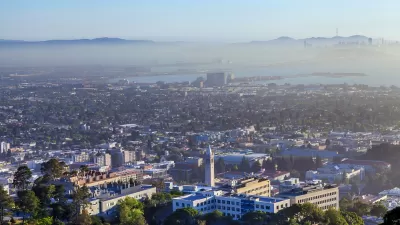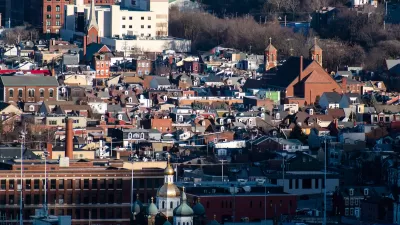Berkeley planning commissioners recommend taller buildings, more density as the city evaluates zoning changes near BART stations.

Emilie Raguso reports on a Berkeley Planning Commission meeting that had at its center a proposal to develop housing on parking lots at two BART stations. At issue during Wednesday's meeting were proposed height limits and the percentage of affordable housing that would be required.
On Wednesday, there were two clear camps among the callers: Those pushing for a higher percentage of affordable units in, primarily, somewhat shorter projects overseen by nonprofit developers and those asserting that the best way to get the highest number of affordable units is to build taller buildings.
While some community members called for a maximum height of seven stories, many Commissioners expressed support for taller buildings of up to 12 stories to accommodate more housing units. Raguso quotes Commissioner Barnali Ghosh as saying, "We have to start making sacrifices here. But I also don’t think of density as a sacrifice."
The proposal for the BART sites and related zoning changes will undergo further consideration by the Berkeley City Council in early 2022. The discussion comes after the council voted to eliminate single-family zoning and minimum parking requirements, reversals on decades-old policies that city leaders hope will help alleviate Berkeley's deepening housing affordability crisis, encourage public transit use, and reduce carbon emissions.
FULL STORY: Planning Commission on BART housing: 7 stories is not enough

Alabama: Trump Terminates Settlements for Black Communities Harmed By Raw Sewage
Trump deemed the landmark civil rights agreement “illegal DEI and environmental justice policy.”

Planetizen Federal Action Tracker
A weekly monitor of how Trump’s orders and actions are impacting planners and planning in America.

The 120 Year Old Tiny Home Villages That Sheltered San Francisco’s Earthquake Refugees
More than a century ago, San Francisco mobilized to house thousands of residents displaced by the 1906 earthquake. Could their strategy offer a model for the present?

LA’s Tree Emergency Goes Beyond Vandalism
After a vandal destroyed dozens of downtown LA trees, Mayor Karen Bass vowed to replace them. Days later, she slashed the city’s tree budget.

Sacramento Leads Nation With Bus-Mounted Bike Lane Enforcement Cameras
The city is the first to use its bus-mounted traffic enforcement system to cite drivers who park or drive in bike lanes.

Seattle Voters Approve Social Housing Referendum
Voters approved a corporate tax to fund the city’s housing authority despite an opposition campaign funded by Amazon and Microsoft.
Urban Design for Planners 1: Software Tools
This six-course series explores essential urban design concepts using open source software and equips planners with the tools they need to participate fully in the urban design process.
Planning for Universal Design
Learn the tools for implementing Universal Design in planning regulations.
Ada County Highway District
Clanton & Associates, Inc.
Jessamine County Fiscal Court
Institute for Housing and Urban Development Studies (IHS)
City of Grandview
Harvard GSD Executive Education
Toledo-Lucas County Plan Commissions
Salt Lake City
NYU Wagner Graduate School of Public Service





























